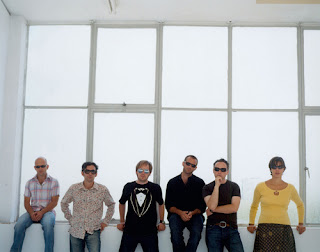This British-French outfit started out in the early 1990s, with a sound that incorporated French-chanteuse vocals, primitive electronics, and Velvet Underground-meets-Neu chugging rhythm. Over the years, they refined their approach immensely, with echoes of sophisticated '60s pop, Steve Reich/Philip Glass-like minimalism, and increasingly more accomplished use of synthesizers. With the help of pals like Gastr Del Sol's Jim O'Rourke and High Llamas mainman Tim O'Hagan, they crafted classic albums that rank among the finest productions of the '90s. In 2002, band member Mary Hansen was killed in a tragic accident, but the group decided to soldier on.



Stereolab are as experimental as ever on this, their eleventh album and first for 4AD. This time around, the sometimes obtuse group has decided to craft short pop songs, built around several series of drum loops and improvised puddles of vibraphones ... Full Descriptionand keyboard. Most bands working from a base of improvisation would be content to sprawl and stretch; it's a testament to Stereolab's professionalism that they go from messy blueprints to a tight end product full of vibrant, sophisticated melodies.
Darkness haunts some of the details, like the trip-hop of "One Finger Symphony" and "Nous Vous Demandons Pardon," which recalls COBRA AND PHASES. For the most part however,
-front.jpg)
Stereolab-Chemical Chords (2008)
CHEMICAL CHORDS is a sunny affair. "Neon Beanbag" opens the album with a bouncy beat and a harpsichord, which resurfaces throughout, notably on "Vortical Phonotheque." Sean O'Hagan's brass arrangements give bounce to the effervescent "Silver Sands" and "Three Women," one of the tracks with French-sung lyrics from Laetitia Sadier. The highlight is the title track--it brims with vintage synths and shoegazery atmospherics, and is as excellent or better than anything in their extensive catalog.
Being released by the iconic legendary label 4AD, Chemical Chords is a collection of purposefully short, dense, fast pop songs, according to Gane, brimming with Motown-like drums, O’Hagan’s finest baroque-pop brass and string arrangements and etched with some of Sadier’s most eloquent, mellifluous vocal performances to date, it is, nonetheless, classic Stereolab; like all their best work, a perfect equipoise between an implausibly cool past and a shamelessly exotic future. The eleventh album in an illustrious career, Chemical Chords began life in early-2007 when Tim Gane started messing with a series of about seventy tiny drum loops on top of improvised chord sequences using piano and vibraphone. Building them up from there later slowing the tracks down or speeding them up a totally new way of doing songs for us With typical prolificacy, the band laboured over the summer at their studio, Instant Zero (in Bordeaux, France), helping transform these blueprints into 32 luminous new songs, with keyboardist/technician Joe Watson manning the mixing desk. Half the new repertoire was selected for this album, which, for all the breathless spontaneity of its invention, is arguably the band’s tautest, most highly focused work this century.

"As many people discovered about ten years ago, how much room can you make in your life for another of their albums, when the results are nearly always the same, no matter how clever? Fans can rejoice, the rest of us can move along..."






No comments:
Post a Comment